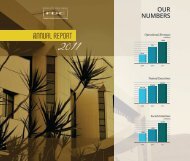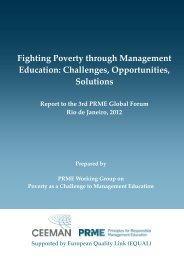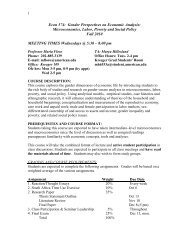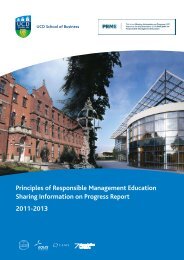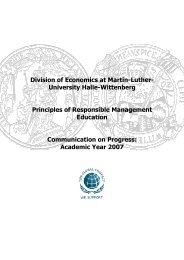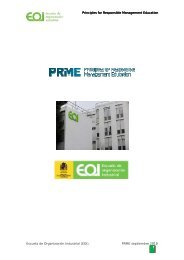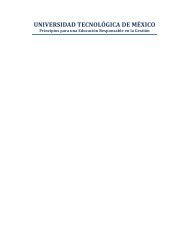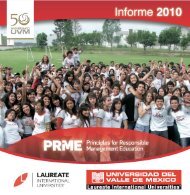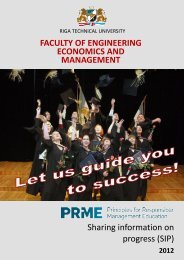PRME SIP report from SB&M, Shaoxing University, January 2012
PRME SIP report from SB&M, Shaoxing University, January 2012
PRME SIP report from SB&M, Shaoxing University, January 2012
Create successful ePaper yourself
Turn your PDF publications into a flip-book with our unique Google optimized e-Paper software.
<strong>PRME</strong> <strong>SIP</strong> Report, <strong>January</strong> <strong>2012</strong><br />
<strong>from</strong> the<br />
School of Business and Management<br />
<strong>Shaoxing</strong> <strong>University</strong>, China<br />
This is the first <strong>PRME</strong> Sharing Information on Progress submitted by the School<br />
of Business and Management, <strong>Shaoxing</strong> <strong>University</strong>, China.<br />
The <strong>report</strong> includes four sections:<br />
Section 1.<br />
Section 2.<br />
Section 3.<br />
Section 4.<br />
Renewal of our commitment to <strong>PRME</strong><br />
The committee's recommendations concerning the creation<br />
of a CSR&GS program<br />
Comments concerning the committee's recommendations<br />
The acceptance, approval, and implementation of the<br />
committee's recommendations<br />
1
Section 2.<br />
The committee's recommendations concerning the creation of a<br />
CSR&GS program<br />
This section of the <strong>report</strong> presents the recommendations that the SB&M <strong>PRME</strong> committee<br />
made to Dean Li Shengxiao concerning the creation of a Corporate Social Responsibility<br />
& Global Sustainability (CSR&GS) program, and the recommendations related to the scope<br />
and phased implementation of the program.<br />
Section 3 of the <strong>report</strong> includes comments concerning the committee's recommendations.<br />
Section 4 covers the acceptance of the committee's recommendations, and the approval and<br />
implementation of the CSR&GS program by the SB&M.<br />
The purpose of these recommendations is to improve the SB&M's educational programs,<br />
to benefit SB&M's students and their prospective employers, to benefit society, and allow<br />
the SB&M to comply with its commitments to <strong>PRME</strong>.<br />
Recommendation 1. The creation of a CSR&GS program<br />
The committee recommends that the SB&M create a Corporate Social Responsibility &<br />
Global Sustainability program that, when fully implemented, will address <strong>PRME</strong> principles<br />
two to six. By addressing these five principles, the CSR&GS program will also address and<br />
satisfy the purpose stated in principle one.<br />
Recommendation 2. The scope of the CSR&GS program<br />
The committee recommends that the CSR&GS program covers three primary areas:<br />
(1) the range of CSR policy options that are available to the boards of directors of<br />
corporations, and the values and beliefs that underlie each of these options;<br />
(2) the United Nations Global Compact (UNGC), its ten principles, its governance, its<br />
operational processes, its local networks, and related UN documents; and<br />
(3) the Global Compact Local Network China (GCLNC), its operations, and the CSR<br />
and sustainability policies and behaviors of its member companies.<br />
3
Recommendation 3. Incremental implementation<br />
The committee recommends that the CSR&GS program be implemented in four phases;<br />
that the implementation of phase 1 should begin in February <strong>2012</strong>, at the start of the Spring<br />
Semester of the 2011 - <strong>2012</strong> academic year; and that all phases of the program should be<br />
implemented within 4 to 5 years.<br />
The focus of phases 1 and 2 is internal; the focus of phases 3 and 4 is external.<br />
Phase 1. Curriculum and teaching. This phase will address <strong>PRME</strong> principles 2 and 3.<br />
Phase 2. Research and publications. This phase will address <strong>PRME</strong> principle 4.<br />
Phase 3. Corporate outreach and training. This phase will address <strong>PRME</strong> principle 5.<br />
Phase 4. Stakeholder outreach and dialogue. This phase will address <strong>PRME</strong> principle 6.<br />
Recommendation 4. Phase 1. Curriculum and teaching<br />
The committee recommends that the curriculum and teaching of CSR and global<br />
sustainability should be embedded in the SB&M's degree programs through the addition of<br />
both integrated elements and separate courses.<br />
(1) Integrated elements. All members of the SB&M's faculty should be required to develop<br />
CSR and global sustainability elements for all of the subject areas they teach, and to include<br />
these elements in all of their courses. To assist faculty to fulfill these requirements, the<br />
SB&M should provide CSR&GS teacher education, advising, and other support.<br />
(2) Separate courses. The SB&M should offer courses called "Corporate Social<br />
Responsibility & Global Sustainability (CSR&GS)" for teachers and students.<br />
The implementation of Phase 1 of the CSR&GC program should begin in the Spring<br />
Semester of <strong>2012</strong>, with teachers adding CSR and global sustainability elements to each of<br />
their courses.<br />
In the Fall Semester of <strong>2012</strong>, the SB&M should begin to offer two CSR&GS courses, one for<br />
for teachers, the other for students.<br />
4
The separate courses should cover the three primary areas discussed in recommendation 2.<br />
The sum of integrated elements included in a course, or set of related courses, should cover<br />
all three primary areas discussed in recommendation 2.<br />
All of the curriculum and teaching components of the CSR&GS program (that is, all of the<br />
integrated elements and the separate courses contained in phase 1 of the program, as well<br />
as the corporate education component contained in phase 3 of the program) should be<br />
taught descriptively rather than prescriptively.<br />
Section 3.<br />
Comments concerning the committee's recommendations<br />
3.a.<br />
<strong>SIP</strong> <strong>report</strong>s by other signatories<br />
The members of the <strong>PRME</strong> committee of the SB&M have read with great interest many of<br />
the more than two hundred <strong>SIP</strong> <strong>report</strong>s provided by other <strong>PRME</strong> signatories. These <strong>report</strong>s<br />
indicate a wide range of approaches that other signatory institutions have taken to their<br />
commitment to apply and to continuously improve their application of the Principles for<br />
Responsible Management Education.<br />
The <strong>SIP</strong> <strong>report</strong>s by other signatory institutions have provided grist for the mill for the<br />
deliberations of the <strong>PRME</strong> committee when formulating recommendations that will improve<br />
the SB&M's educational programs, benefit SB&M students and their prospective employers,<br />
benefit society, and allow the SB&M to comply with its commitments to <strong>PRME</strong>.<br />
3.b.<br />
Recommendation 1. The creation of a CSR&GS program<br />
The School of Business and Management is one of 17 schools at <strong>Shaoxing</strong> <strong>University</strong>.<br />
At this time, the SB&M offers a four-year bachelors degree in three majors: accounting,<br />
management, and international business. For several years the school has been involved in<br />
a process with the Chinese Ministry of Education that we believe will result, in the very near<br />
future, in the school offering a masters degree in management.<br />
5
Unlike many other <strong>PRME</strong> signatories, but like most undergraduate programs in China, the<br />
curricula covering the SB&M's three majors do not currently addresses CSR or the<br />
sustainability issues covered in the ten principles of the Global Compact.<br />
In some cases, an SB&M course may included related CSR material. For example, because<br />
a course on strategic management covers the formulation and implementation of corporate<br />
policy, and because CSR is the responsibility of a company's board of directors, this course<br />
addresses CSR as a primary area of corporate policy. But none of the SB&M's current<br />
courses deals with CSR per se, and/or global sustainability issues.<br />
On the other hand, students and teachers frequently raise issues and questions concerning<br />
CSR and the possible adverse impact of China's economic development on its physical<br />
environment. The CSR&GS program will, therefore, be consistent with the school's<br />
emphasis on student-centered learning and will reflect the values, beliefs, and concerns of<br />
many of the school's students, faculty, and administrators.<br />
3.c.<br />
Recommendation 2. The scope of the CSR&GS program<br />
The scope of the proposed CSR&GS program was influenced by several factors, which<br />
included the choice of a narrow focus, our reading of <strong>SIP</strong> <strong>report</strong>s <strong>from</strong> other <strong>PRME</strong><br />
signatories and the proceedings of the 2 nd <strong>PRME</strong> Asia Forum in Beijing, the preference for<br />
a program that is both global and China centric, and the preference for a document related<br />
company-behavior based program.<br />
3.c.i.<br />
The choice of a narrow focus<br />
The committee's first decision relating to recommendation 2 was that the focus of the<br />
CSR&GS program should be narrow. Unlike many <strong>PRME</strong> signatories that have a long and<br />
impressive record related to the development and implementation of initiatives in the area of<br />
professional ethics, CSR, and societal and environmental sustainability – we are at the<br />
beginning of this process.<br />
We believe that adopting a narrow focus will allow us to maximize the use of our resources,<br />
energies and efforts, and achieve significant results.<br />
6
3.c.ii. Influence of the <strong>report</strong> by Babson College and the 2 nd <strong>PRME</strong> Asia Forum in Beijing<br />
In their 2010 <strong>SIP</strong> <strong>report</strong>, Babson College says that "a more traditional business model has<br />
been to focus upon profit first, and then to allow success in this arena to enable 'giving back'<br />
to people and to environmental sustainability efforts." Babson's new mission and strategy<br />
statements emphasize "embracing 'people, planet, and profit simultaneously.'"<br />
In November 2011, the 2 nd <strong>PRME</strong> Asia Forum was held in Beijing. This forum was attended<br />
by Dean Li Shengxiao, and by the SB&M's <strong>PRME</strong> coordinator, Warnock Davies. The<br />
content of the presentations and of the discussion and comments made during sessions<br />
indicated that at most Asian business schools, and especially Chinese business schools, the<br />
emphasis is on what Babson College calls the "more traditional business model" where the<br />
primary focus is on profits – followed by 'giving back.'<br />
The committee believes that the tendency of participants at the 2 nd <strong>PRME</strong> Asia Forum<br />
in Beijing to focus on 'the more traditional business model' was not anomalous – but is<br />
representative of the business and business-education environments in Asia, and, more<br />
specifically, in China.<br />
One reason we chose to focus on the ten principles of the global compact is that we believe<br />
this will make it possible for the SB&M to emulate the Babson College model and emphasize<br />
embracing 'people, planet, and profit simultaneously.'<br />
3.c.iii. Both global and China centric<br />
The first of the program's three primary areas, which are presented in recommendation 2,<br />
provides an introduction to the range of CSR policy options that are available to the boards<br />
of directors of corporations, and the values and beliefs that underlie each of these options.<br />
These options are global, but can be applied to Chinese companies and to foreign<br />
companies operating in China.<br />
The second primary area, which focuses on the United Nations Global Compact (UNGC), its<br />
ten principles, its governance, its operational processes, its local networks, and related UN<br />
documents – forces the students to think globally.<br />
7
The third primary area, which focuses on the Global Compact Local Network China<br />
(GCLNC), its operations, and the CSR and sustainability policies and behaviors of its<br />
member companies, allows students to see how the global concepts and principles<br />
contained in the UNGC are being applied in China by the GCLNC and by its members.<br />
3.c.iv. Document related and company-behavior based<br />
One of our concerns about the study of CSR and global sustainability is that there is a<br />
tendency for an excess of subjectivity: that too much weight is given to opinions that are not<br />
related to the body of knowledge, are not related to the behaviors of companies, and are not<br />
related to international agreements that influence the international business environment and<br />
affect or govern the conduct of international business.<br />
Primary areas 2 and 3, <strong>from</strong> recommendation 2, will help to correct this tendency. Because<br />
the focus of area 2 is on the UNGC principles and related documents, it will provide a<br />
documental grounding for the study and discussion of CSR and global sustainability.<br />
Because area 3 is on the GCLNC and the behaviors of its member companies, it will allow<br />
the study, analysis, and discussion of CSR and global sustainability to be based on the<br />
behavior of Chinese companies and foreign companies operating in China.<br />
3.d.<br />
Recommendation 3. Incremental implementation<br />
There are two reasons the committee believes the CSR&GS program should be<br />
implemented incrementally, in four phases.<br />
3.d.i.<br />
Learning curves<br />
As discussed in sections 3.b and 3.c.i, the curricula for the SB&M's three majors do not<br />
currently addresses CSR or the sustainability issues covered in the ten principles of the<br />
Global Compact – and we are at the beginning of this process. Because of this, we believe<br />
we must proceed in a manner that allows our internal constituents a reasonable amount of<br />
time to come up the awareness, knowledge, and commitment learning curves that are<br />
associated with SCR and global sustainability.<br />
8
3.d.ii. The availability and use of resources<br />
The second reason is related to resources. As mentioned in section 3.b, the SB&M has<br />
been involved in an extended process with the Chinese Ministry of Education, which we<br />
believe will result in the very near future in the school offering a masters degree in<br />
management. This process has been the major undertaking for the SB&M, and continues to<br />
demand a huge amount of the school's managerial time, energy, and emotional resources.<br />
The committee's recommendation that the CSR&GS program be implemented incrementally,<br />
in four phases, takes into account these two factors; increases the probability that the<br />
committee's recommendations will be approved; and increases the probability that the<br />
implementation of the CSR&GS program will successful and sustainable.<br />
3.e.<br />
Recommendation 4. Phase 1. Curriculum and teaching<br />
The committee believes that the implementation of the CSR&GS program at the SB&M must<br />
begin with curriculum and teaching, and by addressing <strong>PRME</strong> principles 2 and 3, because<br />
this will be the most effective way to achieve internal awareness raising and to bring our<br />
students, teachers, and other internal constituents up the knowledge and commitment<br />
learning curves associated with SCR and global sustainability.<br />
3.e.i.<br />
Integrated elements and separate courses<br />
Since the AACSB introduced its 'internationalization of curricula initiative' in the late 1980s,<br />
there has been a debate concerning the relative benefits and practicality of integrated<br />
elements and separate courses. This issue surfaced in relation to CSR education during<br />
one of the presentations at the 2 nd <strong>PRME</strong> Asia Forum in Beijing. On that occasion, the<br />
presenter said his school had decided in favor of the separate course option, because the<br />
choice of the integrated elements option would have been too difficult in terms of faculty<br />
engagement and mobilization.<br />
We recognize the difficulties expressed by the presenter at the 2 nd <strong>PRME</strong> Asia Forum, but<br />
believe that the use of integrated elements is necessary for two reasons.<br />
9
First, to show students that CSR and global sustainability is influenced by every aspect of a<br />
corporation's operations, and that every aspect of management can influence a company's<br />
CSR and global sustainability behavior, the teaching of CSR&GS must be included in every<br />
subject area of business and management.<br />
Second, we believe that the only way to engage and mobilize faculty to act as agents for<br />
CSR&GS curriculum and teaching is to require that they be active participants in the<br />
process. As business schools found with the internationalization of curricula in the late<br />
1980s and 1990s, the use of separate courses without the use of integrated elements allows<br />
the majority of business and management faculty to abdicate their responsibility for<br />
participating in the curricula transformation process.<br />
3.e.ii. Courses for teachers and students<br />
The implementation of Phase 1, includes CSR&GS courses for both teachers and students.<br />
The courses for teachers will help raise CSR&GS faculty awareness. But the primary<br />
reason for these courses is to provide teachers with the knowledge and skills they will need<br />
to develop a range of CSR&GS integrated elements – and to include these elements in their<br />
general studies, accounting, management, and international business courses.<br />
The courses for students are needed to provide a comprehensive CSR&GS framework that<br />
supports the integrated elements, and to cover areas that may not be covered in the<br />
integrated elements.<br />
3.e.iii. The prescriptive tendency in CSR education<br />
The last paragraph of recommendation 4 says that teaching components of the CSR&GS<br />
program should be taught descriptively rather than prescriptively. The reason for this<br />
recommendation is that the committee is concerned by what can be called the 'prescriptive<br />
tendency' in the teaching and discussion of CSR. This tendency was very evident at the 2 nd<br />
<strong>PRME</strong> Asia Forum in Beijing, where the focus of the discussion in most sessions tended to<br />
prescribe what companies should and should not do.<br />
The CSR&GS program, and its three primary areas, have been designed to enable CSR and<br />
global sustainability to be taught and discussed descriptively, and to offset and help to avoid<br />
the prescriptive tendency by both teachers and students.<br />
10
In recommendation 2, primary area (1), the study and discussion of the range of CSR policy<br />
options that are available to the boards of directors of corporations, and the values and<br />
beliefs that underlie each of these options is descriptive. It focuses on the range of available<br />
options, and the rationales that causes companies to adopt different CSR policies and to<br />
engage in different CSR and global sustainability behaviors.<br />
In recommendation 2, primary area (2), the study and discussion of the Global Compact, its<br />
ten principles, its governance, its operational processes, its local networks, and related UN<br />
documents is descriptive. It avoids the prescriptive tendency by allowing the ten principles<br />
of the Global Compact to prescribe what companies should and should not do.<br />
In recommendation 2, primary area (3), the study and discussion of the Global Compact<br />
Local Network China (GCLNC), its operations, and the CSR and sustainability policies and<br />
behaviors of its member companies is also descriptive. It avoids the prescriptive by focusing<br />
on how the GCLNC and its member companies have implemented and are implementing the<br />
ten principles of the Global Compact.<br />
Section 4.<br />
The acceptance, approval, and implementation of the committee's<br />
recommendations<br />
4.a.<br />
Acceptance<br />
Dean Li Shengxiao has accepted the committee's recommendations, and has approved the<br />
creation of a Corporate Social Responsibility & Global Sustainability (CSR&GS) program.<br />
He has also approved the scope of the CSR&GS program, contained in recommendation 2;<br />
the program's incremental implementation, contained in recommendations 3; and the<br />
implementation details for phase 1, contained in recommendation 4.<br />
11
4.b.<br />
Implementation<br />
Following his attendance at the 2 nd <strong>PRME</strong> Asia Forum, and in anticipation of the 'integrated<br />
elements' component contained in recommendation 4, in November 2011, Dean Li notified<br />
all SB&M faculty to begin developing CSR and global sustainability elements for each of the<br />
subject areas they teach, and to include these elements in their Spring <strong>2012</strong> courses.<br />
Following his acceptance of the committee's recommendations, Dean Li has directed that,<br />
pursuant to the 'separate courses' component of recommendation 4, beginning in the Fall<br />
Semester of <strong>2012</strong>, the SB&M will offer CSR&GS courses for teachers and students.<br />
Pursuant to the last paragraph of recommendation 4, the dean has advised the faculty that<br />
all of the integrated elements and the separate courses contained in phase 1 of the<br />
CSR&GS program should be taught descriptively.<br />
12



